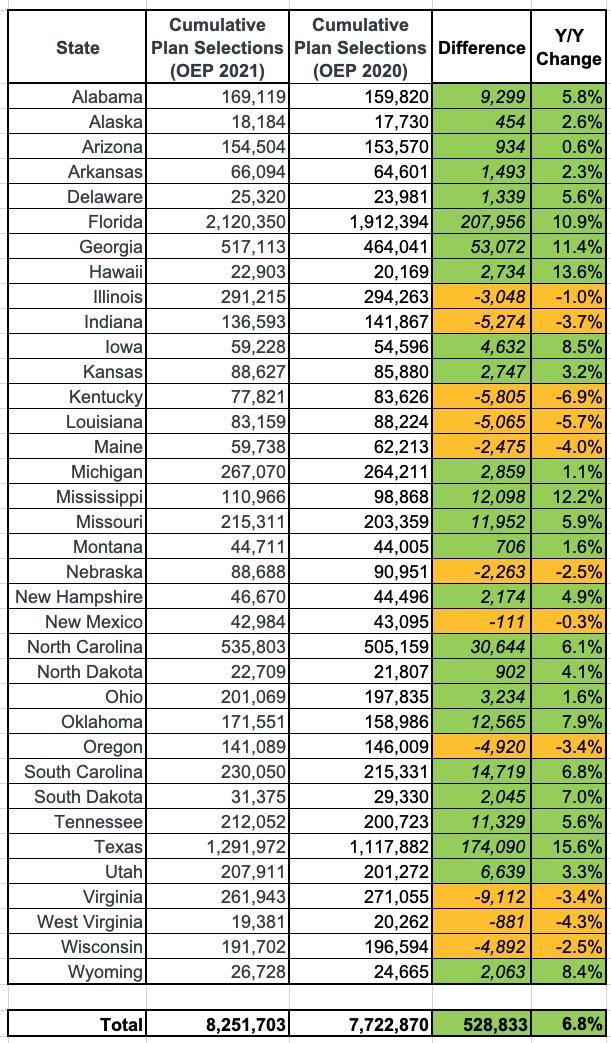2021 OEP HC.gov FINAL Snapshot Report: 8.25 million QHPs
Hot off the presses, via the Centers for Medicare & Medicaid:
Final Snapshot, November 1 - December 21, 2020
Approximately 8.3 million people selected or were automatically re-enrolled in plans using the HealthCare.gov platform during the 2021 Open Enrollment period.
These snapshots provide point-in-time estimates of weekly plan selections, call center activity and visits to HealthCare.gov or CuidadoDeSalud.gov. The final snapshot reports new plan selections, active plan renewals and automatic renewals. It does not report the number of consumers who paid premiums to effectuate their enrollment.
As a reminder, New Jersey and Pennsylvania transitioned to their own State-based Exchange platforms for 2021, thus they are not on the HealthCare.gov platform for 2021 coverage. Those two states accounted for 578,251 plan selections or 7% of all plan selections during the 2020 Open Enrollment Period. Plan selections for 2021 coverage in these two states will not appear in our figures until we announce the State-based Exchange plan selections.
As CMS does each year, a detailed 2021 final enrollment report is scheduled to be released in March, including final plan selection data from State-based Exchanges that do not use the HealthCare.gov platform. Definitions and details on the data are included in the glossary.
...which is 6.8% higher than last year when you remove New Jersey & Pennsylvania, which is pretty good, especially under the circumstances (the pandemic, the looming Supreme Court decision and the ongoing coup attempt by Donald Trump to overthrow the election results).
It's also important to note the breakout between current enrollees actively renewing their policies and new consumers enrolling.
Last year, during Open Enrollment, it was a 75% / 25% split between the two. This year it's split 77% / 23%.
Renewals of existing enrollees are way up: 6,367,529 vs. 5,753,210 last year (without NJ/PA). That's 10.7% higher.
NEW enrollment, however, is concerning. Last year there were 1,955,410 new enrollees via HC.gov (when you remove NJ/PA). This year it's 1,884,174...or 3.6% lower.
Given the massive number of people who have lost their employer-sponsored health insurance since March, you'd normally think that there'd be a surge in new enrollees, especially since many parts of the country have zero premium policies...including zero-premium GOLD plans for many people. And yet, so far, the number of new enrollees is pretty much flat.
This is where a proper awareness/marketing/outreach campaign from the federal government could do wonders...yet Trump's CMS Administrator, Seema Verma, has basically gutted HC.gov's marketing budget.
It's important to note, however, that a big chunk of the surge in renewals could also simply be people who enrolled via Special Enrollment Periods (SEPs) earlier this year who are renewing. While there are SEP enrollees every year, this year there was a surge of at least 188,000 more via HC.gov states than usual due to massive job losses during the COVID-19 pandemic. That report only ran through late June; I'm sure it's more like 250,000 or so by now.
Even if they've only been enrolled for a month or two, they're still considered current enrollees, not new enrollees. In addition, a chunk of current exchange enrollees likely had to downshift to Medicaid instead if they lost their jobs/income...meaning the net impact on total exchange enrollment could be pretty minimal.
Finally, here's the state-level breakout for the 36 states hosted via HC.gov. I've included last year's numbers for comparison:
As you can see, on a per-day average basis, 25 out of 36 states outperformed last yearr. The state with the highest relative perofrmance increase was Texas, which ended up 15.6% higher year over year. The worst-performing state relative to last year was Kentucky, which ended up down 6.9% vs. last year. The most obvious reason for this is Medicaid expansion: Kentucky did it, Texas didn't.
One other noteworthy item: I said last month that I'd be surprised if the final HC.gov enrollment total dropped by more than 10,000 people from the semi-final report relative to OEP 2020, but it turned out that I was still wrong: Final enrollment via the federal exchange is actually around 17,000 higher than it was in the semi-final report, which is surprising but welcome.
How to support my healthcare wonkery:
1. Donate via ActBlue or PayPal
2. Subscribe via Substack.
3. Subscribe via Patreon.





